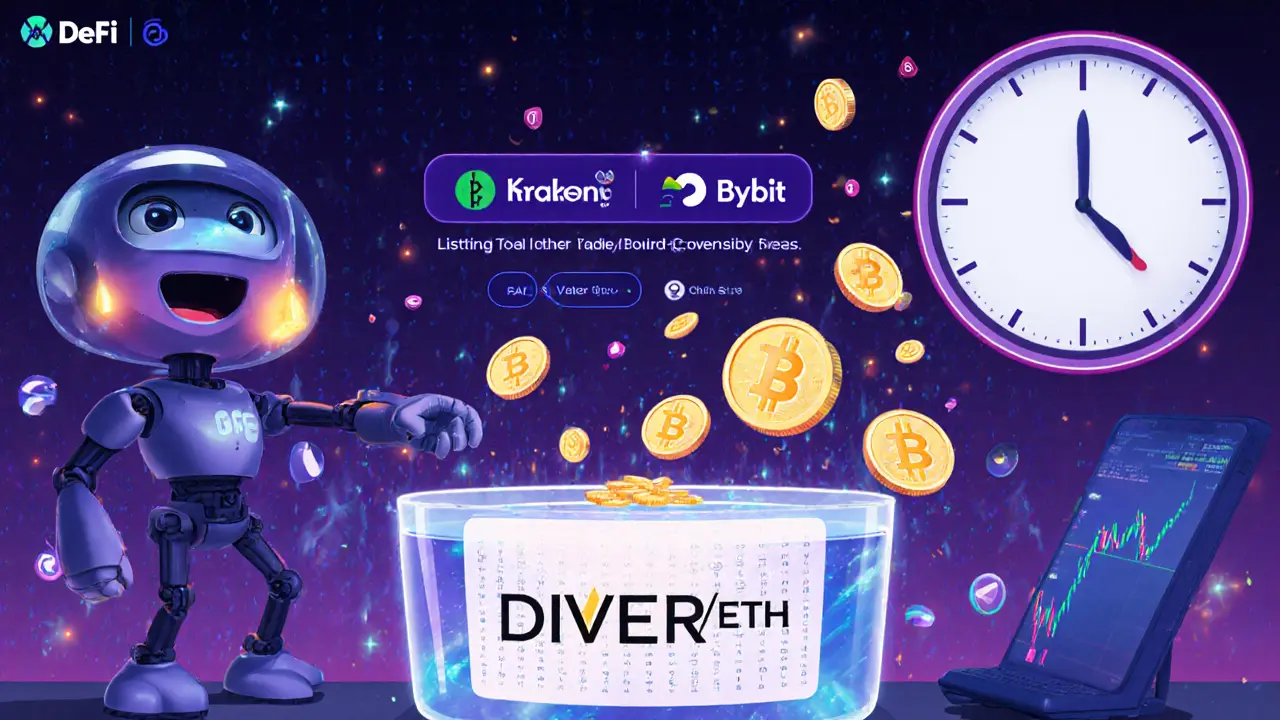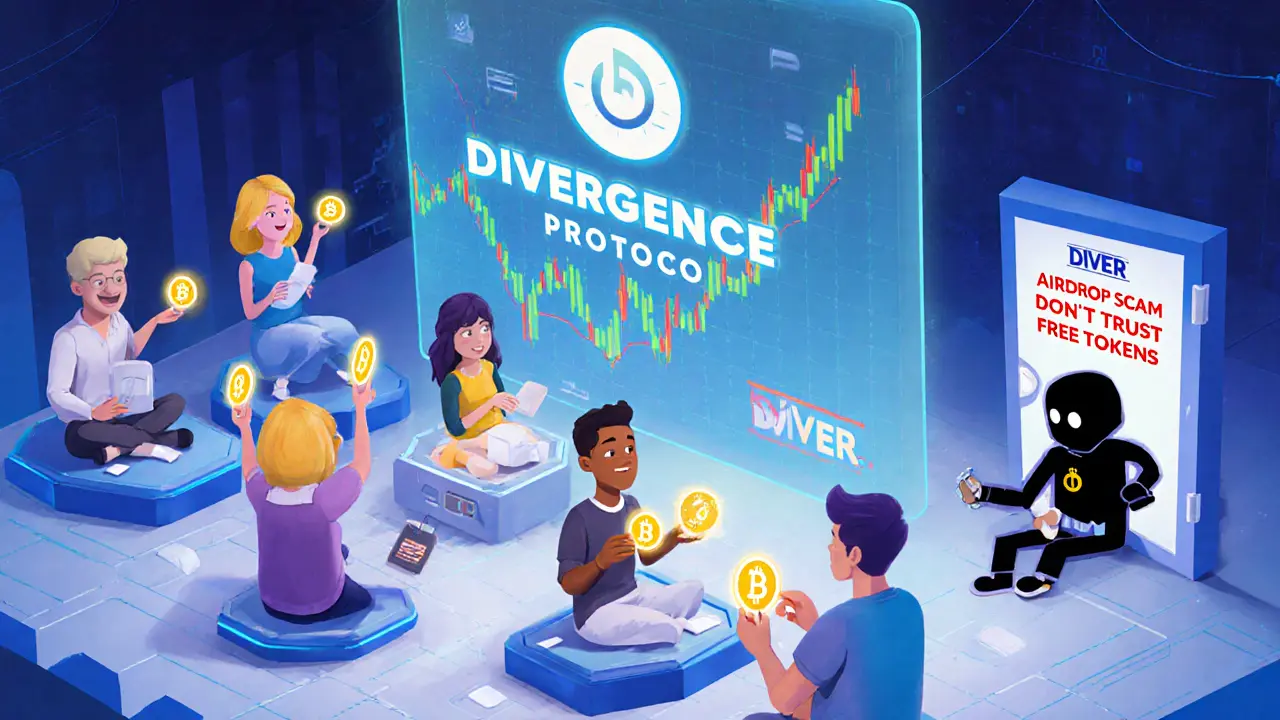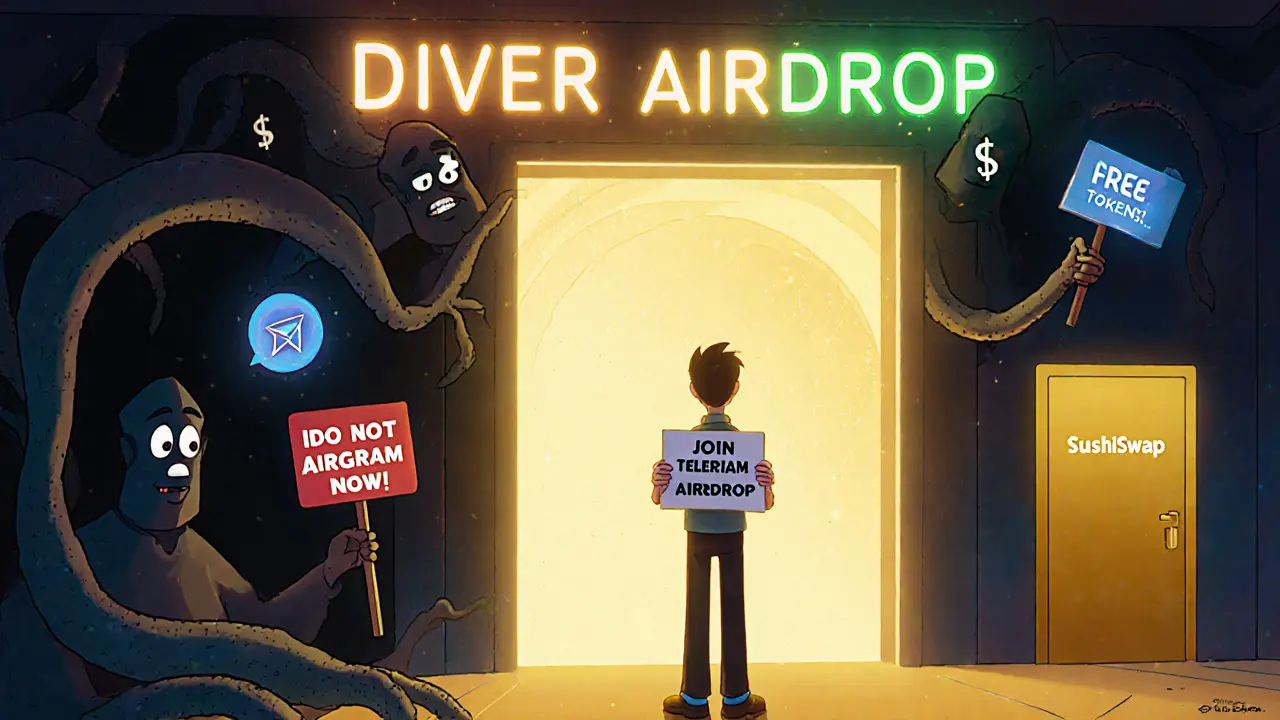DIVER Liquidity Rewards Calculator
How DIVER Rewards Work
DIVER tokens are earned only by providing liquidity to the platform's synthetic options markets. Unlike airdrops, you must actively contribute to the ecosystem to receive rewards. This calculator shows realistic estimates based on current market conditions.
The Divergence (DIVER) airdrop you’ve been hearing about? It doesn’t exist - not the way you think. There’s no free token drop waiting for you to sign up with your wallet. No Twitter giveaway. No Discord raffle. If someone’s promising you free DIVER tokens just for joining their Telegram group, they’re not selling tokens - they’re selling scams.
Divergence Protocol launched with an IDO, not an airdrop. That’s the key difference. An airdrop gives tokens away for free to attract users. An IDO - Initial DEX Offering - is a public sale where people pay for tokens upfront. Divergence did exactly that: a Dutch auction on SushiSwap, starting at $0.10 per DIVER token and dropping to a floor of $0.05. Twenty million tokens were sold in this auction. That’s how the team raised funds and distributed the initial supply.
Today, DIVER trades around $0.010686. That’s down more than 80% from the auction’s starting price. So why are people still talking about an airdrop? Because the project does reward users - just not the way you’d expect. Divergence doesn’t give away tokens for nothing. It pays you in DIVER for doing real work on the platform.
How Divergence Actually Rewards Users
Divergence isn’t a typical DeFi project that just lets you stake and earn. It’s built for hedging volatility in DeFi assets using synthetic binary options. Think of it like betting on whether a token’s price will go up or down in the next 24 hours - but without needing to own the underlying asset. The platform is fully decentralized, permissionless, and designed for traders and liquidity providers who want to profit from market swings.If you want DIVER tokens now, here’s how you earn them:
- Provide liquidity to options markets - When you deposit funds into a liquidity pool for a specific binary option (like ‘Will ETH go above $3,500 in 24 hours?’), you earn trading fees and a share of DIVER rewards.
- Trade synthetic options - Every time you place a trade, you contribute to the platform’s activity. While you don’t get direct rewards for trading, your activity helps maintain healthy markets, which increases the value of the liquidity pools you might later join.
- Hold DIVER for governance - The token isn’t just a reward. It’s your vote. Holding DIVER lets you propose and vote on changes to the protocol - fee structures, new asset listings, liquidity incentives. The more you hold, the more influence you have.
This isn’t a free lunch. It’s a fair system: you put capital or effort in, you get rewarded. No wallet address gets tokens just because it’s old or has been around since 2021. If you’re not contributing to the ecosystem, you’re not getting paid.
Where to Find DIVER Tokens
You won’t find DIVER on Coinbase or Binance. Not yet. The team has said they plan to list on major exchanges, but as of now, the only place to trade it is on SushiSwap. That’s where the majority of the IDO proceeds went - into a DIVER/ETH liquidity pool. That pool is the main source of liquidity for DIVER.To get DIVER tokens:
- Go to SushiSwap (always verify the URL - phishing sites are everywhere).
- Connect your wallet (MetaMask, Coinbase Wallet, etc.).
- Swap ETH or another supported token for DIVER.
- Once you have DIVER, you can add it to liquidity pools or hold it for governance.
Don’t trust any other exchange claiming to list DIVER. If it’s not on SushiSwap or an official announcement from Divergence’s website, it’s fake.
Why There’s No Airdrop - And Why That’s a Good Thing
Most airdrops are marketing gimmicks. They flood the market with tokens, attract speculators, and then the price crashes when everyone dumps. Divergence avoided that. By using a Dutch auction, they ensured early buyers had skin in the game. They didn’t hand out tokens to bots or fake accounts. They sold to real people willing to pay for access.That’s why DIVER’s community is smaller but more active. The people holding DIVER now are likely traders, liquidity providers, or long-term believers - not people who bought a token because they saw it on a Twitter list.
Also, the team didn’t pre-mine a huge chunk of tokens for themselves. The IDO sold 20 million tokens total. The rest is reserved for future liquidity events and exchange listings. That means there’s no massive unlock coming that could crash the price. The supply is tight, and the incentives are aligned.

What You Should Do Right Now
If you’re interested in DIVER, here’s your clear path:- Don’t chase free tokens - There aren’t any. Ignore any Discord or Telegram group promising DIVER airdrops.
- Learn how the platform works - Visit divergence.finance and read the docs. Understand how synthetic binary options work in DeFi.
- Start small with liquidity - Deposit $50 or $100 into a DIVER/ETH pool on SushiSwap. See how fees and rewards work. Don’t go all-in.
- Hold DIVER if you believe in the protocol - If you think DeFi needs better volatility tools, holding DIVER gives you a voice in its future.
There’s no shortcut. No quick win. Just a real DeFi protocol with a real use case - and real risk.
Is Divergence Safe?
No DeFi protocol is 100% safe. Divergence uses audited smart contracts, but audits don’t prevent market risk. If you’re trading binary options, you can lose your entire position if the price moves against you. Liquidity providers can face impermanent loss if the underlying asset’s price swings too much.Here’s what you need to know before you touch DIVER:
- Never invest more than you can afford to lose.
- Use a dedicated wallet for DeFi - don’t use your main exchange wallet.
- Check the contract addresses on Divergence’s official website - never trust links from social media.
- Understand that DIVER’s price is volatile. It’s not a store of value - it’s a utility and governance token.
The project’s long-term success depends on adoption. If more traders start using it to hedge ETH, SOL, or other DeFi assets, demand for DIVER will rise. If it stays niche, the price may stay low. That’s the nature of DeFi.

What’s Next for Divergence?
The team has publicly stated they’re working on listings on centralized exchanges. That’s the next big milestone. If DIVER lands on Kraken or Bybit, liquidity will spike, and the price could recover. But that’s not guaranteed. Many DeFi projects never make it to Tier-1 exchanges.They’re also expanding the types of assets supported. Right now, it’s mostly top-tier DeFi tokens. But future updates could include NFT volatility indices, yield token derivatives, or even real-world asset volatility feeds. That’s where the real potential lies.
For now, Divergence is a tool for experienced DeFi users. It’s not for beginners. It’s not for gamblers. It’s for people who understand volatility and want to trade it without owning the underlying asset.
Is there a Divergence (DIVER) airdrop happening right now?
No, there is no active airdrop for DIVER tokens. The project launched via a Dutch auction IDO, not an airdrop. Any claims of free DIVER tokens are scams. Rewards come only from providing liquidity or participating in governance - not from signing up or sharing your wallet address.
Where can I buy DIVER tokens?
DIVER tokens are only available on SushiSwap as of now. You can swap ETH or other supported tokens for DIVER using the DIVER/ETH liquidity pool. Do not trust any other exchange or website claiming to sell DIVER - they are likely phishing sites.
How do I earn DIVER tokens without buying them?
You earn DIVER by providing liquidity to the platform’s synthetic options markets. When you deposit funds into a liquidity pool for a binary option (like ETH price movements), you earn trading fees and DIVER rewards. Holding DIVER for governance doesn’t earn you tokens - it gives you voting power.
Is Divergence a good investment?
Divergence is not a typical investment. It’s a DeFi tool for trading volatility. DIVER’s value depends on platform usage. If more traders use it to hedge assets, demand for the token rises. But if adoption stays low, the price could stay near $0.01. Only participate if you understand the risks and believe in the protocol’s long-term utility.
What’s the difference between an airdrop and an IDO?
An airdrop gives tokens for free to attract users. An IDO is a public sale where users pay for tokens. Divergence used an IDO - people paid between $0.05 and $0.10 per DIVER token. This means early participants had financial skin in the game, which reduces speculation and pump-and-dump behavior.
Final Thoughts
Divergence isn’t trying to be the next meme coin. It’s building a niche tool for a real problem in DeFi: how to hedge volatility without owning the asset. That’s smart. That’s useful. But it’s not flashy. And it doesn’t hand out free tokens.If you’re looking for a quick gain, walk away. If you’re looking to learn, contribute, and be part of a real DeFi innovation - then dive in. Just don’t expect a free ride. In DeFi, the only thing you get for free is the risk.

dhirendra pratap singh
November 12, 2025 AT 22:50Ashley Mona
November 13, 2025 AT 20:53Edward Phuakwatana
November 13, 2025 AT 21:46Suhail Kashmiri
November 14, 2025 AT 10:02Kristin LeGard
November 15, 2025 AT 21:32Ruby Gilmartin
November 17, 2025 AT 18:29Douglas Tofoli
November 17, 2025 AT 22:32William Moylan
November 19, 2025 AT 10:52Michael Faggard
November 21, 2025 AT 01:41Elizabeth Stavitzke
November 21, 2025 AT 14:01Ainsley Ross
November 23, 2025 AT 04:45Brian Gillespie
November 24, 2025 AT 08:10Wayne Dave Arceo
November 24, 2025 AT 18:23Joanne Lee
November 24, 2025 AT 21:47Laura Hall
November 25, 2025 AT 04:07